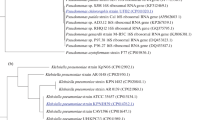Abstract
Desulfomonile tiedjei, a strict anaerobe capable of reductively dechlorinating 3-chlorobenzoate, also dechlorinates tetrachloroethene and trichloroethene. It is not known, however, if the aryl and aliphatic dechlorination activities are catalyzed by the same enzymatic system. Cultures induced for 3-chlorobenzoate activity dechlorinated tetrachloroethene and trichloroethene to lower chlorinated products while uninduced parallel cultures did not dechlorinate either substrate. The observed rate of PCE dechlorination in induced cultures was 22 µmol h−1 g protein−1, which is considerably faster than previous rates obtained with defined cultures of this organism. These results show that both dechlorination activities are co-induced and therefore, that the dechlorination mechanisms may share at least some components.
Similar content being viewed by others
Abbreviations
- PCE:
-
tetrachloroethene
- TCE:
-
trichloroethene
- cis-DCE:
-
cis-dichloroethene
- trans-DCE:
-
trans-dichloroethene
- 3FBz:
-
3-fluorobenzoate
- 3ClBz:
-
3-chlorobenzoate
References
Bouwer EJ & McCarty PL (1983) Transformations of 1- and 2-carbon halogenated aliphatic organic compounds under methanogenic conditions. Appl. Environ. Microbiol. 45: 1286–1294
Brysch K, Schneider C, Fuchs G & Widdel F (1987) Lithoautrophic growth of sulfate-reducing bacteria, and a description ofDesulfobacterium autotrophicum gen. nov., sp. nov. Arch. Microbiol. 148: 262–274
DeWeerd KA, Mandelco L, Tanner RS, Woese CR & Suflita JM (1990)Desulfomonile tiedjei gen. nov. and sp. nov., a novel anaerobic, dehalogenating, sulfate-reducing bacterium. Arch. Microbiol. 154: 23–30
Dolfing J (1990) Reductive dechlorination of 3-chlorobenzoate is coupled to ATP production and growth in an anaerobic bacterium, strain DCB-1. Arch. Microbiol. 153: 264–266
Dolfing J & Tiedje JM (1987) Growth yield increase linked to reductive dechlorination in a defined 3-chlorobenzoate degrading methanogenic coculture. Arch. Microbiol. 149: 102–105
Ewers J, Freier-Schröder D & Knackmuss HJ (1990) Selection of trichloroethene (TCE) degrading bacteria that resist inactivation by TCE. Arch. Microbiol. 154: 410–413
Fathepure BZ, Nengu JP & Boyd SA (1987) Anaerobic bacteria that dechlorinate perchloroethene. Appl. Environ. Microbiol. 53: 2671–2674
Fathepure BZ & Tiedje JM (1994) Reductive dechlorination of tetrachloroethylene by a chlorobenzoate-enriched biofilm reactor. Environ. Sci. Technol. 28: 746–752
Hanson RS & Phillips JA (1981) Chemical composition. In: Gerhardt P (Ed) Manual of Methods for General Bacteriology (pp 328–364). American Society for Microbiology, Washington, DC
Holliger C, Schraa G, Stams AJM & Zehnder AJB (1993) A highly purified enrichment culture couples the reductive dechlorination of tetrachloroethene to growth. Appl. Environ. Microbiol. 59: 2991–2997
Klecka GM & Gonsior SJ (1984) Reductive dechlorination of chlorinated methanes and ethanes by reduced iron (II) porphyrins. Chemosphere 13: 391–402
Krone, UE, Laufer K, Thaure RK & Hogenkamp HPC (1989) Coenzyme F-430 as a possible catalyst for the reductive dehalogenation of chlorinated C-1 hydrocarbons in methanogenic bacteria. Biochemistry 28: 10061–10065
Krone, UE, Thauer RK & Hogenkamp HPC (1989) Reductive dehalogenation of chlorinated C-1 hydrocarbons mediated by corrinoids. Biochemistry 28: 4908–4914
McCarty PL (1988) Bioengineering issues related to in-situ remediation of contaminated soils and groundwater. In: Omen GS (Ed) Environmental Biotechnology (pp 143–162). Plenum Publishing, New York
Mohn WW & Tiedje JM (1990) Strain DCB-1 conserves energy for growth from reductive dechlorination coupled to formate oxidation. Arch. Microbiol. 153: 267–271
Mohn WW, Linkfield TG, Pankratz HS & Tiedje JM (1990) Involvement of a collar structure in polar growth and cell division of strain DCB-1. Appl. Environ. Microbiol. 56: 1206–1211
Nelson MJK, Montgomery SO, Mahaffey WR & Pritchard PH (1987) Biodegradation of trichloroethene and involvement of an aromatic biodegradative pathway. Appl. Environ. Microbiol. 53: 949–954
Shelton DR & Tiedje JM (1984) Isolation and partial characterization of bacteria in an anaerobic consortium that mineralizes 3-chlorobenzoic acid. Appl. Environ. Microbiol. 48: 840–848
Suflita JM, Gibson SA & Beeman RE (1988) Anaerobic biotransformations of pollutant chemicals in aquifers. J. Ind. Microbiol. 3: 179–194
Tandoi V, DeStefano TD, Bowser PA, Gossett JM & Zinder SH (1994) Reductive dehalogenation of chlorinated ethenes and halogenated ethanes by a high-rate anaerobic enrichment culture. Environ. Sci. Technol. 28: 973–979
Tsien HC, Brusseau GA, Hanson RS & Wackett LP (1989) Biodegradation of trichloroethene byMethylosinus trichosporium OB3b. Appl. Environ. Microbiol. 55: 3155–3161
Vogel TM, Criddle CS & McCarty PL (1987) Transformations of halogenated aliphatic compounds. Environ. Sci. Technol. 21: 722–736
Widdel F & Pfennig N (1984) Dissimilatroy sulfate- or sulfur-reducing bacteria. In: Krieg NR & Holt JG (Eds) Bergey's Manual of Systematic Bacteriology, Vol 1 (pp 663–679). Williams & Wilkins, Baltimore
Wood JM, Kennedy FS & Wolfe RS (1968) The reaction of multi-halogenated hydrocarbons with free and bound reduced vitamin B12. Biochemistry 7: 1707–1713
Author information
Authors and Affiliations
Rights and permissions
About this article
Cite this article
Cole, J.R., Fathepure, B.Z. & Tiedje, J.M. Tetrachloroethene and 3-chlorobenzoate dechlorination activities are co-induced inDesulfomonile tiedjei DCB-1. Biodegradation 6, 167–172 (1995). https://doi.org/10.1007/BF00695347
Received:
Accepted:
Issue Date:
DOI: https://doi.org/10.1007/BF00695347




